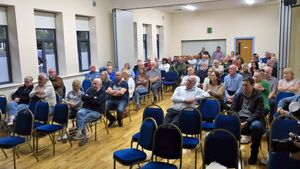Ballyvass plan is something out of 'mad max', meeting told

A vew of the meeting in Castledermot Community Centre
BUILDING something out of ‘Mad Max' in a rural agricultural site is the vista outlined at last week's ‘emergency’ meeting of the Ballyvass Bio Concern Group, called when the planning application for a biogas production plant was recently lodged by Cycle0.
Up to 60 people attended in Castledermot Community Centre, where group member Sandra O’Dwyer said the project has already brought six months of ‘stress, strain and worry’ to the community and has taken ‘a huge toll’ on families. “At a time of financial crisis, we’re all going to have to spend money on submissions. It’s unfair to inflict this on people who are only trying to protect their homes and families. Sadly, we fear this is only the beginning and may continue for many years.” The group has commissioned a planning consultant to help with their objection to the project, but at the meeting, local architect Paddy Byrne detailed how submissions to the planning application should be made. He stressed that every concerned individual, family and household member should prepare individual submissions. He used the submission he is preparing as an example in his presentation and said it would be made available to everybody. But he suggested that they should not ‘copy and paste’ for their own objections. “Write what you need to say yourselves,” he said. “You have got to put pen to paper to say the 12 acres of commercial development in a rural location is crazy. It will destroy the locality.” He set visual impact as a key point of argument, especially given the scale of the proposed plant, with tall buildings and a flare tower. "It’s like something out of Mad Max,” he said, and noted that in pre-planning discussions with the council, the planners had described Ballyvass as a ‘not great’ location and asked the company to consider alternatives, which they had not done.
There would be a ‘significant’ increase in heavy truck traffic on local roads not designed for such volumes. In addition, the access local road junction with the R448 would be hazardous because of the kind and volume of HGVs. Environmental concerns include a potential negative impact on local wetlands and watercourses, with the risk of pollution. The meeting heard of reduced air quality health concerns, particularly from ‘poisons’ in emissions from the flare tower, which represent an increased risk of respiratory problems. The meeting heard that greater carbon emissions from trucks bringing feedstocks to the plant contradict the state’s green agenda. There are also potential impacts on local heritage sites and the historical character of the area, in particular Mullaghreelan hill and woods.
From his examination of the submitted documentation, Mr Byrne outlined several inconsistencies, including an unexplained increase in the plant's capacity from an original 64,000 tonnes to 90,000 tonnes.
Traffic assessment ‘anomalies’ include an analysis based on a 12-hour survey instead of the required 14 days, and the fact that it apparently only covers the entrance onto the local road and not the impact on the regional road.
An inconsistency in land ownership and access is also evident. “There’s a letter of consent from a local landowner, but the access road to the site is actually owned by the council, and there is no documentation granting consent from the council.” The Environmental Impact Assessment is also contentious, claiming the nearest wetland is 13 km away. “Previous surveys and local knowledge indicate a wetland area about 1-1.5 km from the site.” Paddy Byrne also criticised the photographs presented in the Visual Impact Assessment, saying they were taken from locations that minimise the apparent impact, rather than from the most affected viewpoints.
Adding dairy waste to the original list of feedstocks raises concerns about increased odour and waste management. The documentation is also unclear on where the required feedstocks will come from, suggesting that multiple proposed similar projects will rely on the same sources.
The fire safety strategy relies on surface water collected from the site, which raises worries about its adequacy during droughts. The validity of claimed job creation is also disputed. “Most of these seem to be delivery truck drivers, with only a small number of actual staff on the site.” Mr Byrne also suggested much of the documentation lodged is ‘repetitive or irrelevant’, and the volume may be intended to ‘overwhelm’ community objectors and planners reviewing.
The group committed to helping anyone make their submissions and will have workshop sessions before the closing date. People who don’t want to use the online submission system can also bring their written contributions to the Community Centre for bulk delivery before the closing deadline.
Apologies from several public representatives were noted at the meeting, but it was emphasised that they will be held to the support they promised at previous meetings.





